A Superimposition-Based Cephalometric Method to Quantitate Craniofacial Changes
Abstract
1. Introduction
2. Materials and Methods
2.1. Subjects
2.2. Landmarks and Reference Lines
- Five vertical distances, from the landmarks (N, A, B, Pog, Me) to the horizontal reference line NSL;
- Five horizontal distances, from the landmarks (N, A, B, Pog, Me) to the vertical reference line NSLP;
- Three angles (SNA, SNB, ANB) representing the sagittal relation; and
- One angle (ML/NSL) and one linear height (N-Me) representing the vertical relation.
2.3. Different Methods for Growth Evaluation
2.3.1. Conventional Cephalometrics
2.3.2. Conventional Superimposition
2.3.3. Superimposition-Based Cephalometrics (New Method)
2.4. Part I. Evaluation of the Superimposition-Based Cephalometric Method
2.5. Part II. Evaluation of the Different Conventional Superimposition Methods
2.5.1. Validity
2.5.2. Reliability
2.5.3. Workflow—Evaluations of the Different Superimposition Methods (Reliability, Validity)
- SN: Radiographs T1 and T2 were superimposed on the NSL with registration at the sella.
- TW: The TW line was drawn through landmarks T and W on the T1 and T2 radiographs. Radiographs T1 and T2 were superimposed on the TW line with registration at landmark T.
- BD: Radiographs T1 and T2 were superimposed directly, using as good a fit as possible on the anterior part of the sella turcica, the cribriform plate, and the ethmoidal crest.
- BT: The anterior part of the sella turcica, the cribriform plate, and the ethmoidal crest on the T1 radiograph were drawn on a template. Thereafter, the template was superimposed on the T2 radiograph, ensuring the best possible fit for these three structures.
- BS: A positive copy of the T1 radiograph was created. This copy was thereafter superimposed on the T2 radiograph, to subtract details around the anterior contour of the sella turcica, the cribriform plate, and the ethmoidal crest.
2.6. Intra- and Inter-Observer Method Errors
2.7. Statistical Analysis
3. Results
3.1. Part I. Evaluation of the Superimposition-Based Cephalometric Method
3.2. Part II. Evaluations of the Different Superimposition Methods
4. Discussion
5. Conclusions
Author Contributions
Funding
Institutional Review Board Statement
Informed Consent Statement
Data Availability Statement
Acknowledgments
Conflicts of Interest
Appendix A
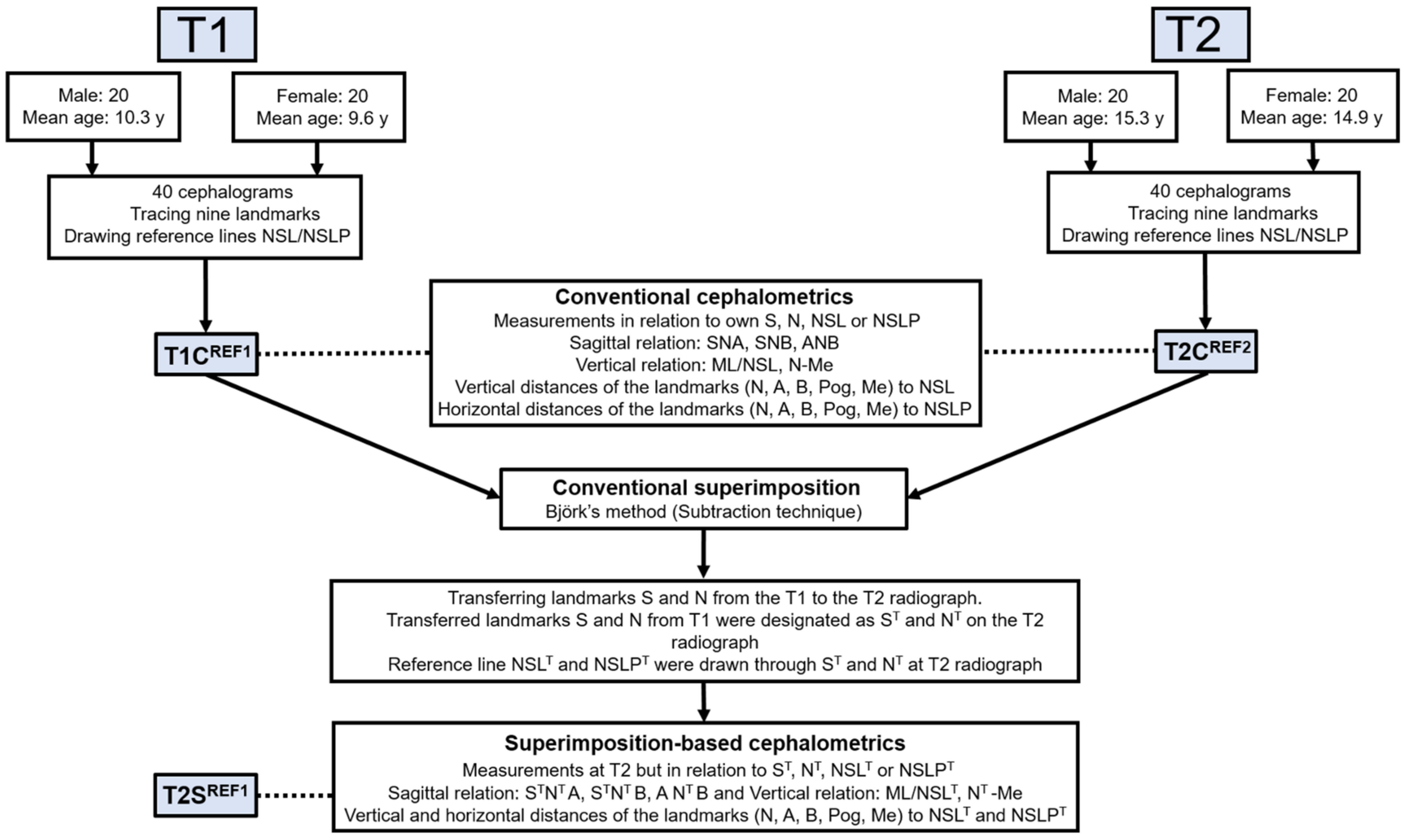

References
- Al Najjar, A.; Colosi, D.; Dauer, L.T.; Prins, R.; Patchell, G.; Branets, I.; Goren, A.D.; Faber, R.D. Comparison of adult and child radiation equivalent doses from 2 dental cone-beam computed tomography units. Am. J. Orthod. Dentofac. Orthop. 2013, 143, 784–792. [Google Scholar] [CrossRef] [PubMed]
- Colceriu-Şimon, I.M.; Băciuţ, M.; Ştiufiuc, R.I.; Aghiorghiesei, A.; Ţărmure, V.; Lenghel, M.; Hedeşiu, M.; Băciuţ, G. Clinical indications and radiation doses of cone beam computed tomography in orthodontics. Med. Pharm. Rep. 2019, 92, 346–351. [Google Scholar] [CrossRef] [PubMed]
- Signorelli, L.; Patcas, R.; Peltomäki, T.; Schätzle, M. Radiation dose of cone-beam computed tomography compared to conventional radiographs in orthodontics. J. Orofac. Orthop. 2016, 77, 9–15. [Google Scholar] [CrossRef]
- Ghafari, J.; Baumrind, S.; Efstratiadis, S.S. Misinterpreting growth and treatment outcome from serial cephalographs. Clin. Orthod. Res. 1998, 1, 102–106. [Google Scholar] [CrossRef]
- Taylor, C.M. Changes in the relationship of nasion, point A, and point B and the effect upon ANB. Am. J. Orthod. 1969, 56, 143–163. [Google Scholar] [CrossRef]
- Björk, A.; Skieller, V. Normal and abnormal growth of the mandible. A synthesis of longitudinal cephalometric implant studies over a period of 25 years. Eur. J. Orthod. 1983, 5, 1–46. [Google Scholar] [CrossRef] [PubMed]
- Duterloo, H.S.; Planché, P.-G. Handbook of Cephalometric Superimposition; Quintessence Publishing: Hanover Park, IL, USA, 2011. [Google Scholar]
- Ghafari, J.; Efstratiadis, S.S. Mandibular displacement and dentitional changes during orthodontic treatment and growth. Am. J. Orthod. Dentofac. Orthop. 1989, 95, 12–19. [Google Scholar] [CrossRef]
- Kristensen, B. Cephalometric Superimposition: Growth and Treatment Evaluation; The Royal Dental College: Aarhus, Denmark, 1989. [Google Scholar]
- Athanasiou, A. Orthodontic Cephalometry; Mosby-Wolfe: London, UK, 1995. [Google Scholar]
- Steiner, C. Cephalometrics in clinical practice. Angle Orthod. 1959, 29, 8–29. [Google Scholar] [CrossRef]
- Afrand, M.; Ling, C.P.; Khosrotehrani, S.; Flores-Mir, C.; Lagravere-Vich, M.O. Anterior cranial-base time-related changes: A systematic review. Am. J. Orthod. Dentofac. Orthop. 2014, 146, 21–32.e6. [Google Scholar] [CrossRef]
- Ford, E. Growth of the human cranial base. Am. J. Orthod. 1958, 44, 498–506. [Google Scholar] [CrossRef]
- Melsen, B. The cranial base: The postnatal development of the cranial base studied histologically on human autopsy material; Acta Odontologica Scandinavica; Aarhus University Press: Aarhus, Denmark, 1974; Volume 32, pp. 1–126. [Google Scholar]
- Arat, Z.M.; Turkkahraman, H.; English, J.D.; Gallerano, R.L.; Boley, J.C. Longitudinal growth changes of the cranial base from puberty to adulthood. A comparison of different superimposition methods. Angle Orthod. 2010, 80, 537–544. [Google Scholar] [CrossRef]
- Nelson, T. Analysis of facial growth utilizing elements of the cranial base as registrations. Am. J. Orthod. 1960, 46, 379. [Google Scholar]
- Baumrind, S.; Miller, D.; Molthen, R. The reliability of head film measurements: 3. Tracing superimposition. Am. J. Orthod. 1976, 70, 617–644. [Google Scholar] [CrossRef]
- Ghafari, J.; Engel, F.E.; Laster, L.L. Cephalometric superimposition on the cranial base: A review and a comparison of four methods. Am. J. Orthod. Dentofac. Orthop. 1987, 91, 403–413. [Google Scholar] [CrossRef]
- McWilliam, J.S. The application of photographic subtraction in longitudinal cephalometric growth studies. Eur. J. Orthod. 1982, 4, 29–36. [Google Scholar] [CrossRef]
- McWilliam, J.S. The effect of growth on the precision of subtraction superimposition. Dentomaxillofac. Radiol. 1983, 12, 61–69. [Google Scholar] [CrossRef]
- Houston, W.J.; Lee, R.T. Accuracy of different methods of radiographic superimposition on cranial base structures. Eur. J. Orthod. 1985, 7, 127–135. [Google Scholar] [CrossRef]
- Lenza, M.A.; Carvalho, A.A.; Lenza, E.B.; Lenza, M.G.; Torres, H.M.; Souza, J.B. Radiographic evaluation of orthodontic treatment by means of four different cephalometric superimposition methods. Dental Press J. Orthod. 2015, 20, 29–36. [Google Scholar] [CrossRef][Green Version]
- Pancherz, H.; Hansen, K. The nasion-sella reference line in cephalometry: A methodologic study. Am. J. Orthod. 1984, 86, 427–434. [Google Scholar] [CrossRef]
- You, Q.L.; Hagg, U. A comparison of three superimposition methods. Eur. J. Orthod. 1999, 21, 717–725. [Google Scholar] [CrossRef]
- Ekström, C. Facial growth rate and its relation to somatic maturation in healthy children. Swed. Dent. J. Suppl. 1982, 11, 1–99. [Google Scholar] [CrossRef]
- Naoumova, J.; Lindman, R. A comparison of manual traced images and corresponding scanned radiographs digitally traced. Eur. J. Orthod. 2009, 31, 247–253. [Google Scholar] [CrossRef] [PubMed]
- Roden-Johnson, D.; English, J.; Gallerano, R. Comparison of hand-traced and computerized cephalograms: Landmark identification, measurement, and superimposition accuracy. Am. J. Orthod. Dentofac. Orthop. 2008, 133, 556–564. [Google Scholar] [CrossRef]
- Baumrind, S.; Frantz, R.C. The reliability of head film measurements: 1. Landmark identification. Am. J. Orthod. 1971, 60, 111–127. [Google Scholar] [CrossRef]
- Jackson, P.H.; Dickson, G.C.; Birnie, D.J. Digital image processing of cephalometric radiographs: A preliminary report. Br. J. Orthod. 1985, 12, 122–132. [Google Scholar] [CrossRef] [PubMed]
- Marshal, W.A.; Tannrer, J.M. Puberty. In Human Growth, 2nd ed.; Falkner, F., Tanner, J.M., Eds.; Plenum Publishing: New York, NY, USA, 1986. [Google Scholar]
- Lo Giudice, A.; Ronsivalle, V.; Grippaudo, C.; Lucchese, A.; Muraglie, S.; Lagravère, M.O.; Isola, G. One Step before 3D Printing-Evaluation of Imaging Software Accuracy for 3-Dimensional Analysis of the Mandible: A Comparative Study Using a Surface-to-Surface Matching Technique. Materials 2020, 13, 2798. [Google Scholar] [CrossRef] [PubMed]
- Lo Giudice, A.; Leonardi, R.; Ronsivalle, V.; Allegrini, S.; Lagravère, M.; Marzo, G.; Isola, G. Evaluation of pulp cavity/chamber changes after tooth-borne and bone-borne rapid maxillary expansions: A CBCT study using surface-based superimposition and deviation analysis. Clin. Oral Investig. 2021, 25, 2237–2247. [Google Scholar] [CrossRef] [PubMed]
- Bazina, M.; Cevidanes, L.; Ruellas, A.; Valiathan, M.; Quereshy, F.; Syed, A.; Wu, R.; Palomo, J.M. Precision and reliability of Dolphin 3-dimensional voxel-based superimposition. Am. J. Orthod. Dentofac. Orthop. 2018, 153, 599–606. [Google Scholar] [CrossRef] [PubMed]
- Häner, S.T.; Kanavakis, G.; Matthey, F.; Gkantidis, N. Voxel-based superimposition of serial craniofacial CBCTs: Reliability, reproducibility and segmentation effect on hard-tissue outcomes. Orthod. Craniofac. Res. 2020, 23, 92–101. [Google Scholar] [CrossRef]
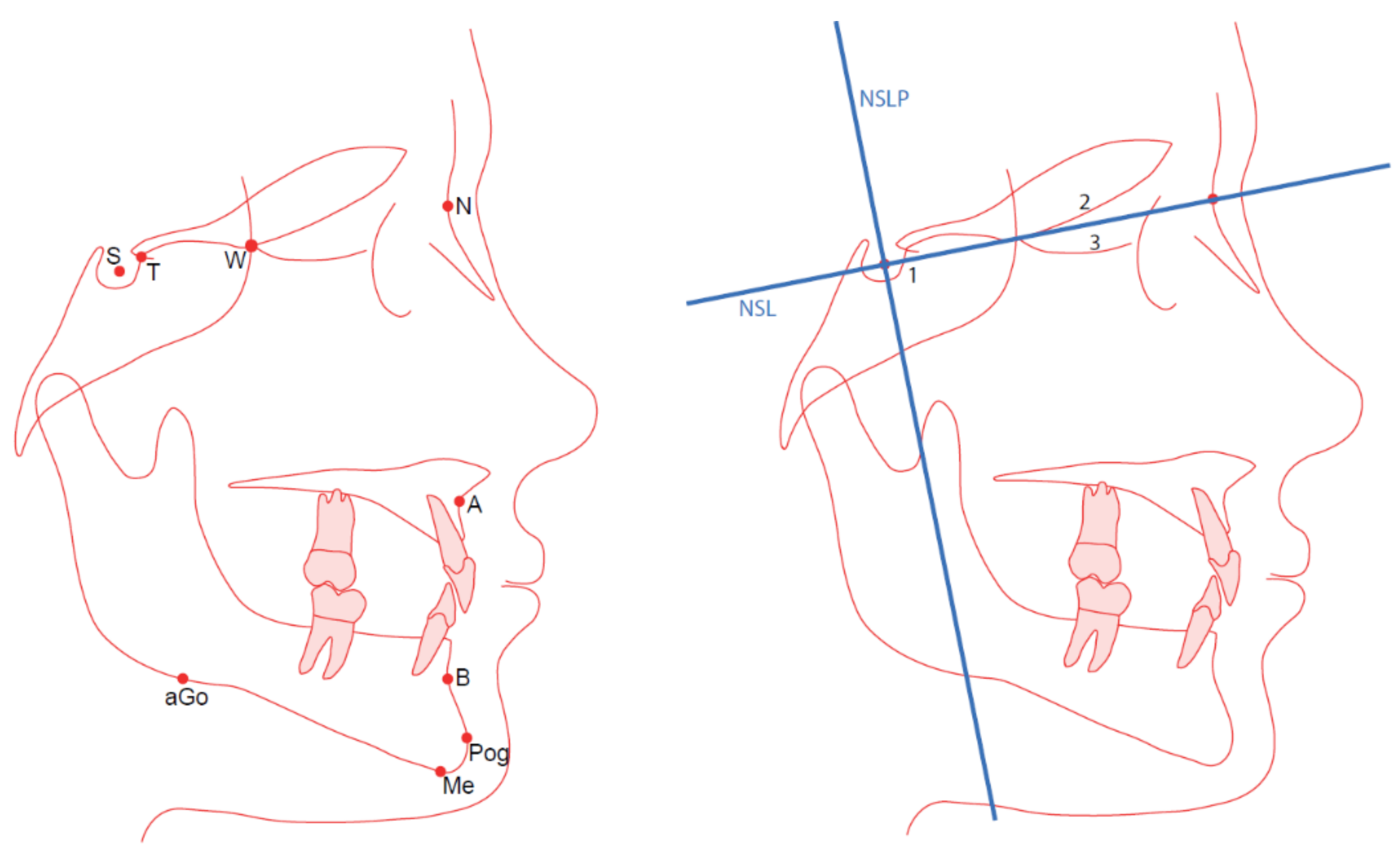
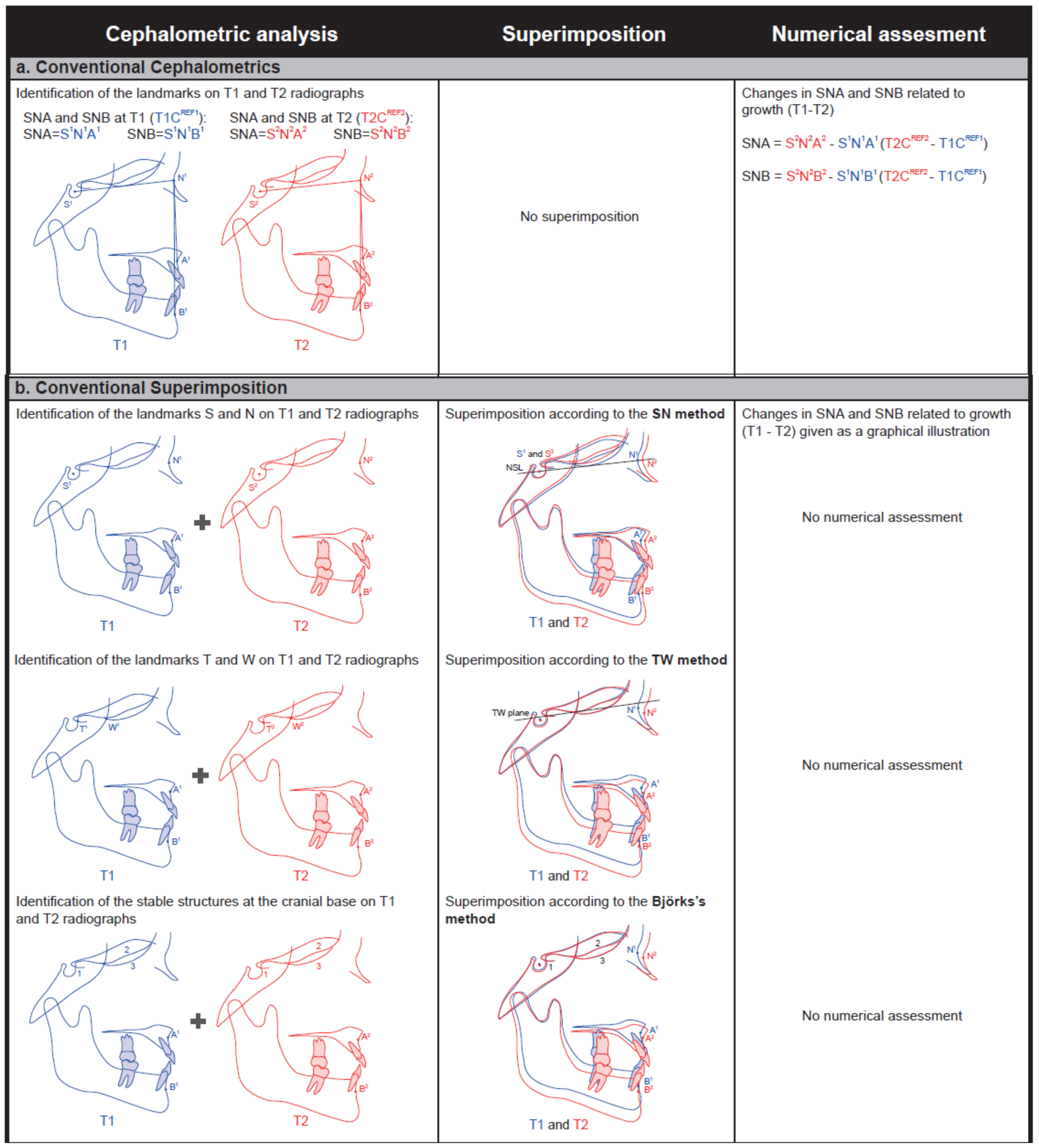

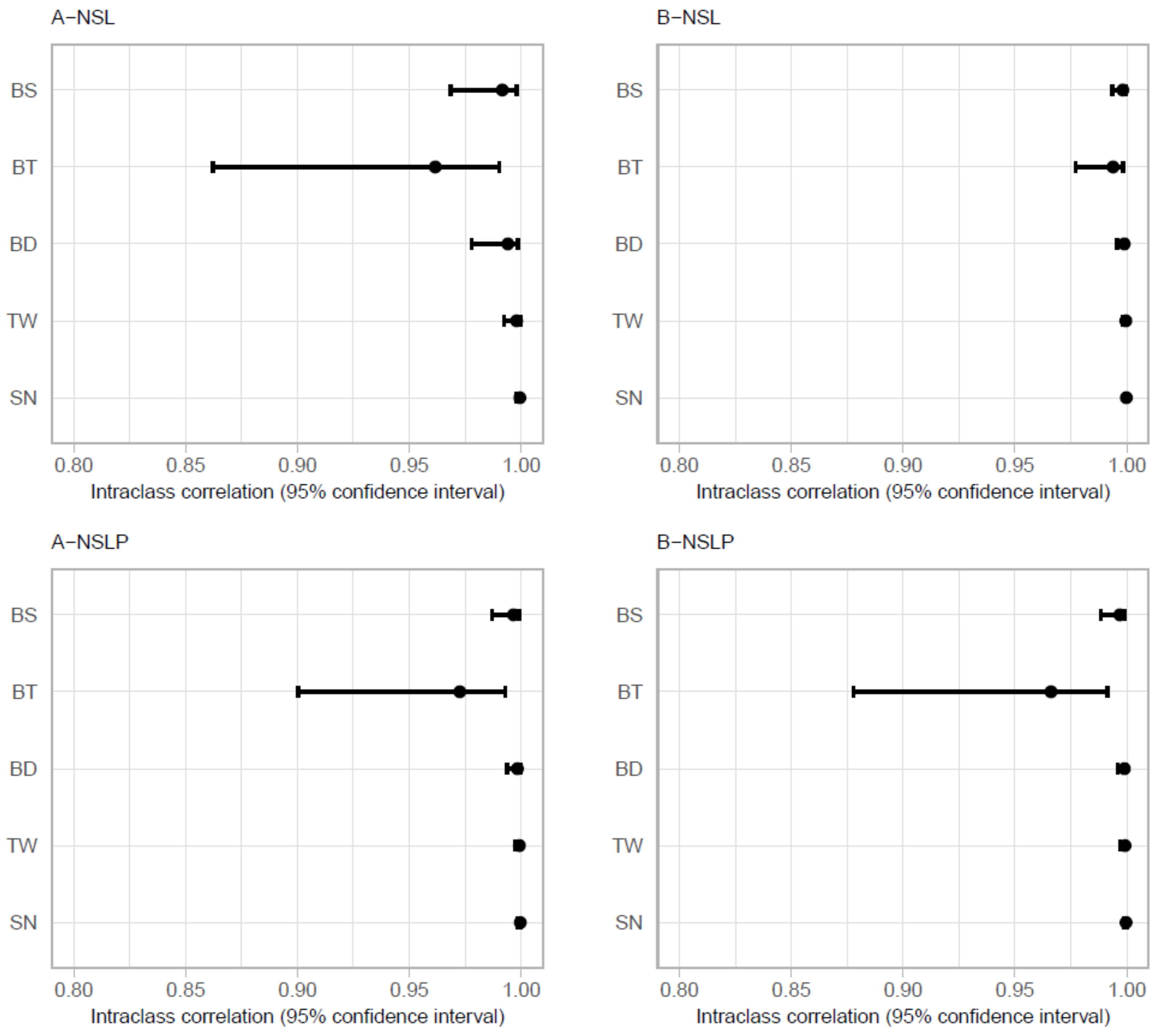
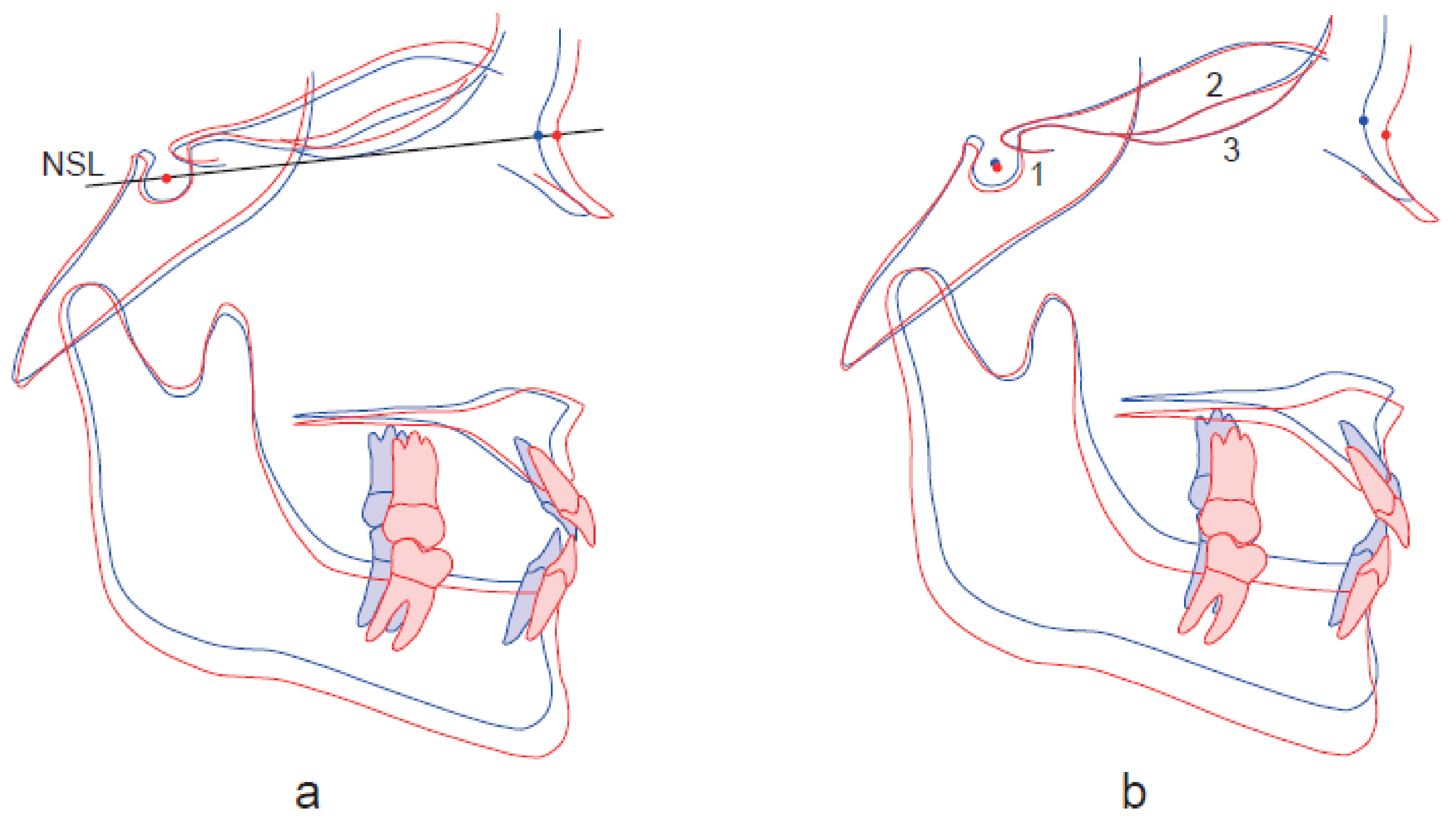
| Variables | Mean (SD) | p-Value 1 |
|---|---|---|
| SNA (°) | 3.64 (2.62) | <0.001 |
| SNB (°) | 2.28 (1.67) | <0.001 |
| ANB (°) | 1.36 (1.01) | <0.001 |
| ML/NSL (°) | 0.04 (0.76) | 0.71 |
| N-Me (mm) | −0.45 (1.11) | 0.014 |
| Variables | SN | TW | BD | BT | BS | p-Value 1 |
|---|---|---|---|---|---|---|
| A-NSL (mm) | 6.4 (2.3) | 6.6 (2.3) | 6.4 (2.1) | 6.6 (2.2) | 6.6 (2.3) | 0.61 |
| B-NSL (mm) | 8.5 (3.2) | 8.8 (3.2) | 8.6 (3.2) | 8.7 (3.2) | 8.8 (3.3) | 0.489 |
| N-NSL (mm) | 0.0 (0.085) | 0.18 (1.5) | 0.063 (0.94) | 0.20 (1.6) | 0.27 (0.95) | 0.707 |
| Pog-NSL (mm) | 11 (3.6) | 11 (3.6) | 11 (3.6) | 11 (3.6) | 11 (3.6) | 0.458 |
| Me-NSL (mm) | 11 (3.8) | 11 (3.8) | 11 (3.7) | 11 (3.8) | 11 (3.8) | 0.337 |
| A-NSLP (mm) | 4.7 (2.1) | 4.3 (2.2) | 4.1 (2.2) | 3.9 (2.1) | 3.9 (2.2) | <0.001 *** |
| B-NSLP (mm) | 4.4 (3.2) | 4.1 (3.0) | 3.8 (3.1) | 3.5 (3.0) | 3.6 (3.2) | 0.0351 * |
| N-NSLP (mm) | 4.4 (2.6) | 3.9 (2.6) | 3.7 (2.6) | 3.8 (2.5) | 3.7 (2.5) | <0.001 *** |
| Pog-NSLP (mm) | 5.3 (3.9) | 4.9 (3.5) | 4.6 (3.7) | 4.3 (3.5) | 4.5 (3.8) | 0.0693 |
| Me-NSLP (mm) | 5.3 (4.0) | 4.9 (3.7) | 4.6 (3.8) | 4.3 (3.6) | 4.4 (3.8) | 0.0931 |
| SNA (°) | 1.3 (2.9) | 5.3 (2.3) | 5.0 (2.2) | 4.9 (2.1) | 4.9 (2.3) | <0.001 *** |
| SNB (°) | 1.2 (2.4) | 3.7 (1.9) | 3.5 (2.0) | 3.4 (1.9) | 3.4 (2.0) | <0.001 *** |
| ANB (°) | 0.12 (1.3) | 1.6 (1.3) | 1.5 (1.3) | 1.5 (1.3) | 1.5 (1.3) | <0.001 *** |
| ML/NSL (°) | −2.7 (3.0) | −2.8 (2.9) | −2.7 (3.0) | −2.5 (2.6) | −2.7 (2.9) | 0.768 |
| N-Me (mm) | 11 (4.0) | 10 (3.6) | 10 (3.5) | 10 (3.5) | 10 (3.6) | 0.0176 * |
| Variables | TW-SN | BD-SN | BT-SN | BS-SN | BD-TW | BT-TW | BS-TW | BT-BD | BS-BD | BS-BT |
|---|---|---|---|---|---|---|---|---|---|---|
| A-NSLP | 0.316 | 0.017 | 0.001 | 0.002 | 0.729 | 0.291 | 0.335 | 0.951 | 0.969 | 1.000 |
| B-NSLP | 0.805 | 0.266 | 0.045 | 0.081 | 0.894 | 0.437 | 0.586 | 0.933 | 0.981 | 0.999 |
| N-NSLP | <0.001 | <0.001 | <0.001 | <0.001 | 0.079 | 0.260 | 0.066 | 0.981 | 0.907 | 0.609 |
| SNA | <0.001 | <0.001 | <0.001 | <0.001 | 0.950 | 0.828 | 0.842 | 0.997 | 0.998 | 1.000 |
| SNB | <0.001 | <0.001 | <0.001 | <0.001 | 0.954 | 0.698 | 0.853 | 0.978 | 0.998 | 0.999 |
| ANB | <0.001 | <0.001 | <0.001 | <0.001 | 0.967 | 0.999 | 0.911 | 0.995 | 1.000 | 0.975 |
| N-Me | 0.051 | 0.016 | 0.080 | 0.185 | 0.995 | 1.000 | 0.981 | 0.978 | 0.875 | 0.996 |
| A-NSL | B-NSL | N-NSL | Pog-NSL | Me-NSL | A-NSLP | B-NSLP | N-NSLP | Pog-NSLP | Me-NSLP | |
|---|---|---|---|---|---|---|---|---|---|---|
| SN | 0.999 | 1.000 | 0.000 * | 1.000 | 1.000 | 1.000 | 1.000 | 1.000 | 1.000 | 1.000 |
| TW | 0.998 | 1.000 | 0.990 | 1.000 | 1.000 | 0.999 | 0.999 | 1.000 | 0.999 | 0.999 |
| BD | 0.994 | 0.999 | 0.934 | 0.999 | 0.999 | 0.998 | 0.999 | 0.999 | 0.999 | 0.998 |
| BT | 0.962 | 0.994 | 0.846 | 0.994 | 0.996 | 0.973 | 0.966 | 0.998 | 0.959 | 0.953 |
| BS | 0.992 | 0.998 | 0.879 | 0.998 | 0.999 | 0.997 | 0.997 | 0.997 | 0.996 | 0.995 |
| A-NSL | B-NSL | N-NSL | Pog-NSL | Me-NSL | A-NSLP | B-NSLP | N-NSLP | Pog-NSLP | Me-NSLP | |
|---|---|---|---|---|---|---|---|---|---|---|
| SN | 0.912 | 0.991 | 0.862 | 0.991 | 0.997 | 0.987 | 0.985 | 0.988 | 0.985 | 0.980 |
| TW | 0.925 | 0.987 | 0.760 | 0.981 | 0.991 | 0.963 | 0.955 | 0.977 | 0.966 | 0.962 |
| BD | 0.970 | 0.994 | 0.492 | 0.993 | 0.994 | 0.994 | 0.997 | 0.991 | 0.997 | 0.997 |
| BT | 0.838 | 0.972 | 0.000 * | 0.970 | 0.977 | 0.962 | 0.960 | 0.990 | 0.952 | 0.943 |
| BS | 0.975 | 0.995 | 0.483 | 0.995 | 0.995 | 0.994 | 0.997 | 0.990 | 0.997 | 0.997 |
Publisher’s Note: MDPI stays neutral with regard to jurisdictional claims in published maps and institutional affiliations. |
© 2021 by the authors. Licensee MDPI, Basel, Switzerland. This article is an open access article distributed under the terms and conditions of the Creative Commons Attribution (CC BY) license (https://creativecommons.org/licenses/by/4.0/).
Share and Cite
Al-Taai, N.; Levring Jäghagen, E.; Persson, M.; Ransjö, M.; Westerlund, A. A Superimposition-Based Cephalometric Method to Quantitate Craniofacial Changes. Int. J. Environ. Res. Public Health 2021, 18, 5260. https://doi.org/10.3390/ijerph18105260
Al-Taai N, Levring Jäghagen E, Persson M, Ransjö M, Westerlund A. A Superimposition-Based Cephalometric Method to Quantitate Craniofacial Changes. International Journal of Environmental Research and Public Health. 2021; 18(10):5260. https://doi.org/10.3390/ijerph18105260
Chicago/Turabian StyleAl-Taai, Nameer, Eva Levring Jäghagen, Maurits Persson, Maria Ransjö, and Anna Westerlund. 2021. "A Superimposition-Based Cephalometric Method to Quantitate Craniofacial Changes" International Journal of Environmental Research and Public Health 18, no. 10: 5260. https://doi.org/10.3390/ijerph18105260
APA StyleAl-Taai, N., Levring Jäghagen, E., Persson, M., Ransjö, M., & Westerlund, A. (2021). A Superimposition-Based Cephalometric Method to Quantitate Craniofacial Changes. International Journal of Environmental Research and Public Health, 18(10), 5260. https://doi.org/10.3390/ijerph18105260






